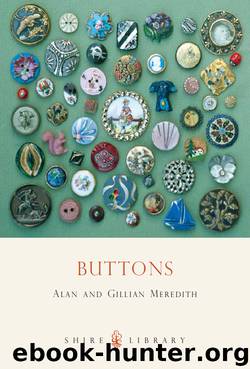Buttons by Alan Meredith

Author:Alan Meredith
Language: eng
Format: epub
Tags: Buttons
ISBN: 9780747811794
Publisher: Osprey Publishing
Published: 2011-09-18T16:00:00+00:00
Materials – non-metals
As buttons have such a small surface area it is difficult to identify some materials. The necessary tests with chemicals or hot needles could well damage the button. Late-twentieth-century washing liquids and powders are chemically very different from the products in use earlier in the century. If it is necessary to use more than just a cloth to clean a plain non-metal button, use an appropriate product for the material. Natural plastics, bone, nut, ivory or wood respond well to a waxy furniture polish, but care must be taken not to remove patina or decoration.
Bakelite, introduced in 1907, is the earliest of the man-made plastics in use in button-making.
Bone was the staple material used to make the utilitarian sew-through buttons for underwear. It was also used as a base for decorative work and in a carved form with a metal loop shank. With a pinhead shank, it was used to make overall buttons and, because of its strength and resistance to salt water and most chemicals, this type continued to be made until the early 1960s. A natural black vegetable dye was effective on bone but otherwise it would not readily take colouring. Most commonly the dense surface of the leg bone, closely resembling ivory, was used. Look on the back of the button for straight, parallel grain lines and the minute grooves that carried the blood vessels. They appear in cross-section as tiny holes.
Casein, a natural plastic made from curdled milk, was developed in the 1890s. The original formula would not take fast dyes, and sunlight caused fading and cracking. The material, much improved, was in wide use by the 1930s and production continued until the 1970s.
Celluloid, a natural plastic developed from wood flour or cotton fibre, was patented in 1869. At the end of the nineteenth century it was used only sparingly as part of the decoration of buttons, owing to its expense. By the early twentieth century, with cheaper production methods, it was used to form an entire covering of metal-backed buttons. Its vogue did not last long as it was highly inflammable.
Download
This site does not store any files on its server. We only index and link to content provided by other sites. Please contact the content providers to delete copyright contents if any and email us, we'll remove relevant links or contents immediately.
| Beadwork | Jewelry |
| Rock & Gem Crafts |
On Writing A Memoir of the Craft by Stephen King(4261)
The Doodle Revolution by Sunni Brown(4079)
A Simplified Life by Emily Ley(3603)
Mummy Knew by Lisa James(3187)
Marijuana Grower's Handbook by Ed Rosenthal(3152)
Paper Parties by Erin Hung(3058)
Better Homes and Gardens New Cookbook by Better Homes & Gardens(2986)
Figure Drawing for Artists by Steve Huston(2827)
Draw Your Day by Samantha Dion Baker(2733)
The Genius of Japanese Carpentry by Azby Brown(2638)
Japanese Design by Patricia J. Graham(2583)
Lions and Lace by Meagan Mckinney(2518)
Dangerous Girls by Haas Abigail(2506)
The Curated Closet by Anuschka Rees(2417)
How to Make Your Own Soap by Sally Hornsey(2374)
Zero to Make by David Lang(2363)
The Wardrobe Wakeup by Lois Joy Johnson(2253)
The Code Book by Simon Singh(2248)
The Checklist Manifesto by Atul Gawande(2231)
